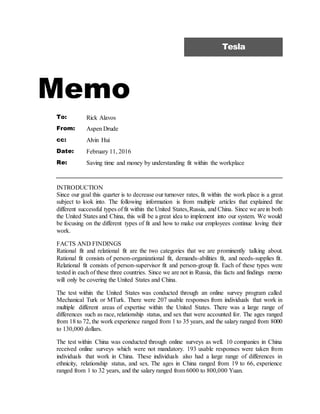Report
Share

Recommended
Recommended
More Related Content
Similar to Memo - Staffing Feb 11
Similar to Memo - Staffing Feb 11 (20)
Post #1Employee empowerment has allowed organizations to have qu.docx

Post #1Employee empowerment has allowed organizations to have qu.docx
Reply to 2 these 2 posts. Attempt to draw a parallel between these .docx

Reply to 2 these 2 posts. Attempt to draw a parallel between these .docx
Work Life Integration - Human Capital Insights - Vol. 6

Work Life Integration - Human Capital Insights - Vol. 6
Learning Activity #1Relate to the class an experience that you h.docx

Learning Activity #1Relate to the class an experience that you h.docx
Why Attracting and Retaining Diverse Talent is a Strategic Priority

Why Attracting and Retaining Diverse Talent is a Strategic Priority
The effects of cultural dimensions and hr practices on organisational commitment

The effects of cultural dimensions and hr practices on organisational commitment
Memo - Staffing Feb 11
- 1. Tesla Memo To: Rick Alavos From: Aspen Drude cc: Alvin Hui Date: February 11, 2016 Re: Saving time and money by understanding fit within the workplace INTRODUCTION Since our goal this quarter is to decrease our turnover rates, fit within the work place is a great subject to look into. The following information is from multiple articles that explained the different successful types of fit within the United States,Russia, and China. Since we arein both the United States and China, this will be a great idea to implement into our system. We would be focusing on the different types of fit and how to make our employees continue loving their work. FACTS AND FINDINGS Rational fit and relational fit are the two categories that we are prominently talking about. Rational fit consists of person-organizational fit, demands-abilities fit, and needs-supplies fit. Relational fit consists of person-supervisor fit and person-group fit. Each of these types were tested in each of these three countries. Since we are not in Russia, this facts and findings memo will only be covering the United States and China. The test within the United States was conducted through an online survey program called Mechanical Turk or MTurk. There were 207 usable responses from individuals that work in multiple different areas of expertise within the United States. There was a large range of differences such as race, relationship status, and sex that were accounted for. The ages ranged from 18 to 72, the work experience ranged from 1 to 35 years, and the salary ranged from 8000 to 130,000 dollars. The test within China was conducted through online surveys as well. 10 companies in China received online surveys which were not mandatory. 193 usable responses were taken from individuals that work in China. These individuals also had a large range of differences in ethnicity, relationship status, and sex. The ages in China ranged from 19 to 66, experience ranged from 1 to 32 years, and the salary ranged from 6000 to 800,000 Yuan.
- 2. 2 Within these surveys, the individuals were asked questions about salary, past promotions, perceived organizational constraints, collectivistic values, and perceived fit. They were scaled with yes and no answers, open ended answers, scales from one to five, and scales from one to seven. The surveys found that: Average salary predicts demands-ability fit only in China. Positive correspondence between average salary and need-supply fit only in China Past promotion is positively associated with demands-ability fit in both the United States and China Positive relationships between past promotions and need-ability fit only in China Organizational constraints held negative in only the United States Organizational constraints are negatively related to need-supply fit perceptions in both the United States and China. Collectivistic values have a positive correspondence with person-organization fit only in the United States Relationships between average salary and need-supply fit is stronger in China than in the United States Relationships between collectivistic values and person-organization fit is stronger in the United States than it is in China (Astakhova, Doty, Hang, 2014). DISCUSSION Essentially, what is being said within this article is that we should really think about how someone is going to fit into our organization before we even offer them a position. This should decrease our turnover rates for this quarter and help us maintain our key employees. RECOMMENDATIONS I recommend that we put a system into place that uses these statistics that I have found to determine fit within our organization. Doing this will increase retention rates and keep our employees happy, both in China and the United States! By taking culture into account, I really think it would improve our company not only by reducing turnover, but also by presenting a better, more employee-friendly environment to our customers and employees. Please call me at (251) 509-9963if you have any questions. I think that if we implemented this program byApril 1st we could save up to $350,000injust one quarter assuming that eachperson has an average turnover cost of $3500 (Gupta, 2013). I would love to implement this by next quarter. Thank you for your time.
- 3. 3 REFERENCE PAGE Astakhova, M. N., Doty, D. H., & Hang, H. (2014). Understanding the antecedents of perceived fit at work in the United States, Russia, and China. European Management Journal, 32(6), 879-890. Retrieved January 29, 2016. Gupta, V. (2013). Effects of Person Organization Fit on Satisfaction, Commitment, and Turnover. Retrieved February 01, 2016, from https://www.kon.org/urc/v12/gupta.html